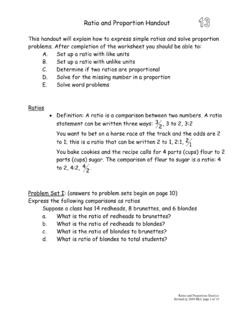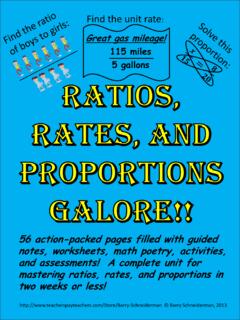Transcription of Ratios – A Co-Teaching Lesson Plan
1 Ratios A Co-Teaching Lesson plan Co-Teaching Approaches A (Y) in front of the following list items indicates the approach is outlined in the Lesson . An (N) in front of the following list items indicates the approach is not outlined in the Lesson . (Y) Parallel teaching (N) Station teaching (N) Alternative teaching (Y) Team teaching (Y) One Teach/One Observe (Y) One Teach/One Assist Subject Grade 6 Mathematics Strand Number and Number Sense Topic Represent relationships between quantities using Ratios SOL. a The student will represent relationships between quantities using Ratios , and will use appropriate notations, such as , a to b, b and a:b. Outcomes The students will use color tiles (or construction paper squares) to describe and compare two sets of data, using Ratios and appropriate notations.
2 Materials Sets of 20 red and 30 yellow color tiles or construction paper squares Red and yellow colored pencils Survey Questions (attached). The Frame Diagram and key (attached). 1. Understanding Ratios worksheet (attached). Grid (attached). Understanding Ratios - Extension worksheet (attached). Exit Ticket Examples (attached). Ratios worksheet (attached). Vocabulary ratio - comparison of any two quantities. Co-Teacher Actions Lesson Co-Teaching General Educator (GE) Special Educator (SE). Component Approach(es). Anticipatory Set Team Teach GE assists students in answering Survey SE assists students as they enter the Questions. classroom. SE helps them quickly answer Survey Questions posted around GE distributes the Frame Diagram and the room.
3 Introduces Ratios . GE completes diagram with the whole class, filling it in as the SE tells students we will be using this discussion dictates. information throughout the unit. GE discusses the different types of Ratios SE participates in discussion of the and introduces the three ways to write framing routine. SE modifies notes as Ratios and the different ways to compare appropriate (see accommodations and quantities. GE engages class in modifications below for suggestions). discussion as to why fractions are only appropriate for part to whole Ratios . GE explains that order matters when properly representing relationships within and between sets. For example, if asked for the ratio of the number of cats to dogs in a park, the ratio must be expressed as the number of cats to the number of dogs, 2.
4 Lesson Co-Teaching General Educator (GE) Special Educator (SE). Component Approach(es). in that order. GE asks students to compare the number of boys in the class to the number of girls. GE asks students to compare the number of girls to the number of boys. Has them write each comparison in the three ratio notations. For example, for 6 boys and 3. girls, the ratio of boys to girls is 6 to 3, 6:3, which simplifies to 2:1, while the ratio of girls to boys is 3 to 6, 3:6, which simplifies to 1:2. Because this example is part to part, the fraction form would not be appropriate. The ratio of girl to total class would be 3 to 9, 3:9, or 3/9, which simplifies to 1/3. Because this example is part to whole, the fraction would be appropriate.
5 GE discusses that like fractions, Ratios should be simplified. Students can work in groups so that group members can confer. GE instructs students to write the ratio of boys to all students in the class (6 to 9, 6:9, or 6/9, which simplifies to 2/3 for the above example. GE asks students to describe the relationship between the way the question is asked and the way the ratio is written. (The set named first goes first in the ratio.) GE leads discussion on this 3. Lesson Co-Teaching General Educator (GE) Special Educator (SE). Component Approach(es). concept. Lesson Parallel Teach GE distributes the sets of red and yellow SE distributes the sets of red and yellow Activities/ color tiles or squares, colored pencils, color tiles or squares, colored pencils, Procedures sheets of grid paper, and the sheets of grid paper, and the Understanding Ratios worksheet to half Understanding Ratios worksheet to the of the class.)
6 GE gives students a few other half of the class. SE gives students minutes to experiment with putting a few minutes to experiment with together various sets of red and yellow putting together various sets of red and tiles or squares. yellow tiles or squares. GE has students complete the first activity on the worksheet and has students color the set on the grid paper and number the picture, as well as write SE completes the same grid activity with the Ratios requested. It is very important the other group. SE may need to that students use the squares or tiles, complete one set of grid sheets for the color the grid, and write the ratio. GE entire group instead of each person, or reviews the answers with the students. reduce the number of problems the students are expected to complete.
7 GE has students complete the worksheet. During the activity, GE should monitor their work to make sure they are focusing on the relationships between the identified sets. Some students may begin to notice similarities in the sets. GE may need to reduce the number of problems the students are expected to complete. When students are finished, GE discusses When students are finished, SE discusses and answers and what relationships and answers and what relationships students have discovered from activity. students have discovered from activity. 4. Lesson Co-Teaching General Educator (GE) Special Educator (SE). Component Approach(es). Guided/ Alternative teaching GE distributes the Understanding Ratios SE continues working with any students Independent Extension worksheet to students who who need more practice or Practice have grasped concepts from previous clarification/discussion with the grid activity.
8 GE reminds students that their activity. answers are to be complete statements. If students noticed the relationships when completing the problems on the previous worksheet, GE asks them to explain how they figured it out. Several explanations are valid, including, separating set four into two groups, each of which looks like set one, or the numbers were doubled. GE allows students to exchange their worksheets and check the work of a fellow student. Closure Team Teach GE has students write a definition and/or SE has students write a definition and/or give verbal description of ratio and give give verbal description of ratio and give several examples of a ratio. several examples of a ratio. Formative One Teach GE instructs students to complete the exit GE instructs students to complete the Assessment One Assist ticket and assists as needed.
9 Exit ticket and assists as needed. Strategies Homework Team Teach GE may assign the attached Ratios SE may modify and/or reduce worksheet worksheet to students for homework. GE homework assignment, as necessary, for reminds students to write each ratio all designated students requiring shortened three ways. assignments. Specially Designed Instruction 5. The teacher will explicitly teach how to use the Frame Diagram worksheet (or other graphic organizer) to visually represent all the different components of Ratios and how they are written. Teacher will use think aloud strategy as he/she uses the graphic organizer. The teacher can break down the three different ways to write Ratios into more manageable chunks. For example, have students identify Ratios using the word to first, and then move on to the other ways after they have shown mastery.
10 Another prerequisite skill the teacher may need to explicitly review first is the idea that fractions are part to whole representations, and how to simplify fractions. Accommodations On the Frame Diagram worksheet, some students may need a completed copy of these notes, but with some blanks (cloze procedures) or a completed copy that they can highlight, as noted in the students' IEPs. Keep in mind that this routine is supposed to be fluid and change according to students' comments and suggestions. During the Lesson , students could work in pairs or groups of three to manipulate one set of grid sheets and red and yellow tiles instead of each student completing the Lesson individually. For students who struggle to communicate with peers or think abstractly, prompting and additional questioning may be needed from a teacher when students are required to work in pairs.
















